Onions are a staple crop in European cuisine, appearing in nearly every soup, stew, and main dish. Surprisingly, onions contain more natural sugars than apples and pears. When cooked, their characteristic bitterness fades, revealing a sweet, mellow flavor. However, growing this essential and nutritious crop isn’t always easy. Onion beds are prone to diseases that reduce yields or even kill the plants.
This article explores fungal and viral diseases affecting onions, along with treatment and prevention methods. You’ll learn what to do if your onions develop gray mold or black spots, and how to manage storage-related diseases.
Table of contents
How to Identify a Diseased Onion
Diseases and pests are the primary causes of reduced yields and storage losses in bulb onions, spring onions, and other Allium varieties.
Onions are susceptible to fungal, bacterial, and viral infections. Disease outbreaks are often linked to poor crop rotation and cultivation practices.
Botanically, onions belong to the Amaryllidaceae family. Like other members of this group, they require protection from harmful microorganisms and disease-carrying insects.
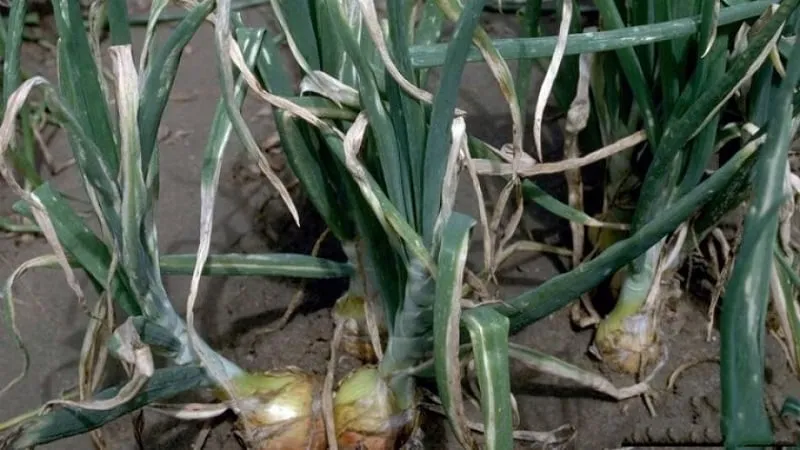
Symptoms and Signs
Diseases can affect both the foliage and bulbs. Timely intervention is crucial to prevent crop loss.
Watch for these warning signs:
- yellowing, wilting, or deformed leaves;
- spots or mold on foliage or bulbs;
- changes in leaf or bulb texture;
- black specks on onions.
Types of Onion Diseases
Onion diseases fall into three main categories:
- fungal;
- viral;
- bacterial.
Fungal Foliage Diseases
Onion leaves are vulnerable to:
- downy mildew;
- alternaria leaf blight;
- rust.
Downy Mildew
Downy mildew (Peronospora destructor) — a widespread fungal disease affecting all onion varieties. Infected seedlings appear healthy in spring, but within 20-30 days, plants begin to wilt.
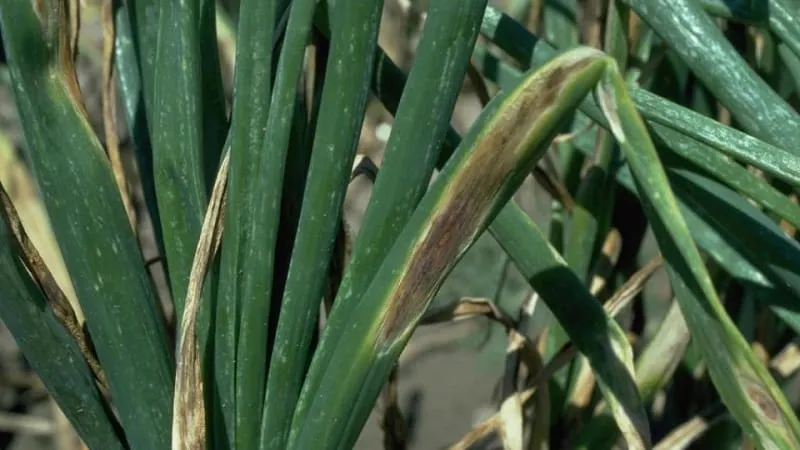
Initial symptoms appear at leaf tips, which yellow and curl. Later, yellow spots spread across leaves, developing gray-purple mold in humid weather. The fungus eventually invades the bulb.
Warning. Shaded areas, low-lying beds, cloudy weather, and overcrowding accelerate fungal growth.
The disease thrives in humid conditions (15-20°C). In unfavorable conditions, the fungus becomes dormant but survives.
Infection sources include contaminated seeds and poor crop rotation. Sets carrying spores remain infectious until the next planting season. The pathogen overwinters in seeds and plant debris.
Alternaria Leaf Blight
A fast-spreading fungal disease common across European onion-growing regions. Symptoms emerge within days of infection.
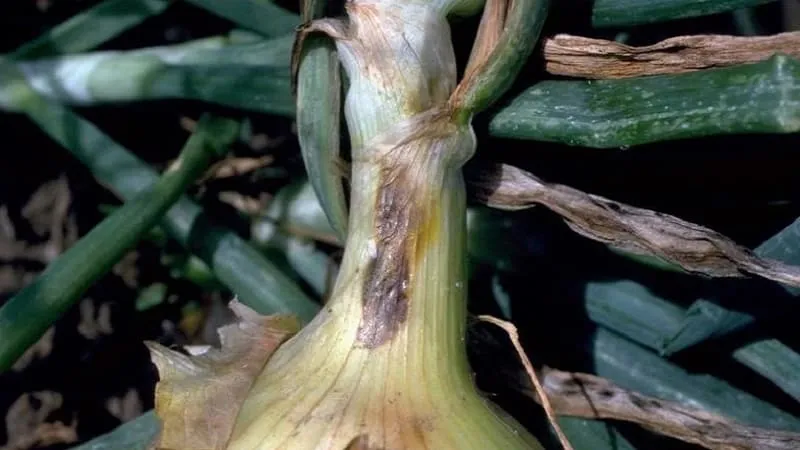
White-centered water-soaked spots appear first, later turning dark burgundy with yellow halos.
Note. Alternaria often targets weak, aging plants or those already infected with downy mildew. Leaves blacken and die.
The fungus eventually attacks bulbs, causing watery decay between scales. Spores overwinter in plant debris and spread via wind.
Rust
Caused by Puccinia porri, favoring warm, damp conditions. Identified by small orange-yellow pustules that blacken with age.
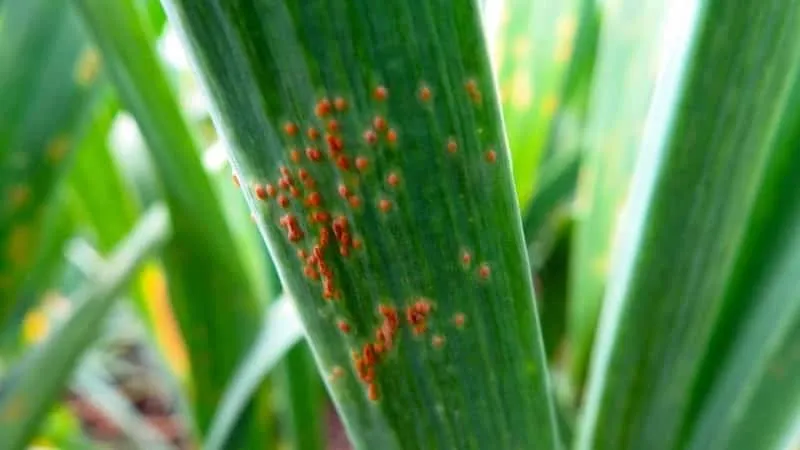
Spreads to currants and shrubs. Early planting, overcrowding, weeds, and overwatering promote outbreaks.
Key fact. Rust spores only germinate on wet leaves. Prolonged rain creates ideal conditions.
Fungal Bulb Diseases
Bulbs are vulnerable to:
- neck rot;
- fusarium basal rot;
- green mold rot;
- aspergillus rot.
Neck Rot
Caused by fungi decomposing plant matter. First appears as yellowing at the neck, spreading downward.
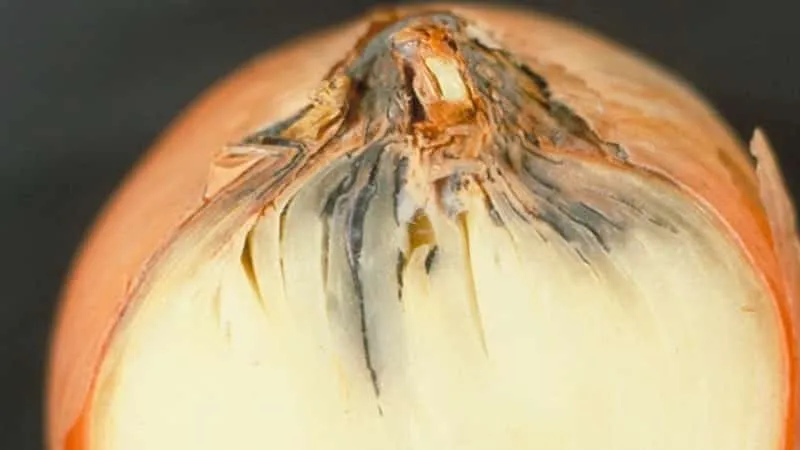
Infected bulbs develop loose scales and foul odors. Dark lesions appear at the base when cut open.
Fusarium Basal Rot
Soil-borne pathogen that first attacks leaf tips before progressing downward, causing bulb rot. Tissues become soft and watery.

Triggered by waterlogged soil, late harvests, or infected sets.
You might find useful:
Growing onions in plastic bottles
Planting onions in autumn
Pre-winter onion treatment
Green Mold Rot
Storage-related fungal infection. Symptoms include dried outer scales and green mold on bulb bases after 2-3 months.
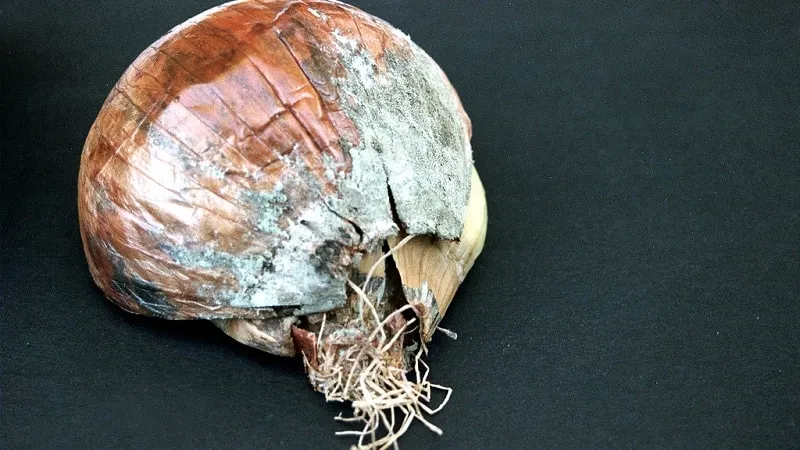
Caused by harvest damage, storage above 3°C, or humidity exceeding 60%.
Aspergillus Rot
Aspergillus niger — a major post-harvest threat. During growth, symptoms are subtle, often limited to neck discoloration where the fungus enters.
Black spores hide under dry scales before tissues become watery. Eventually, black spore masses form.
Important. Aspergillus often invites secondary infections causing soft rot.
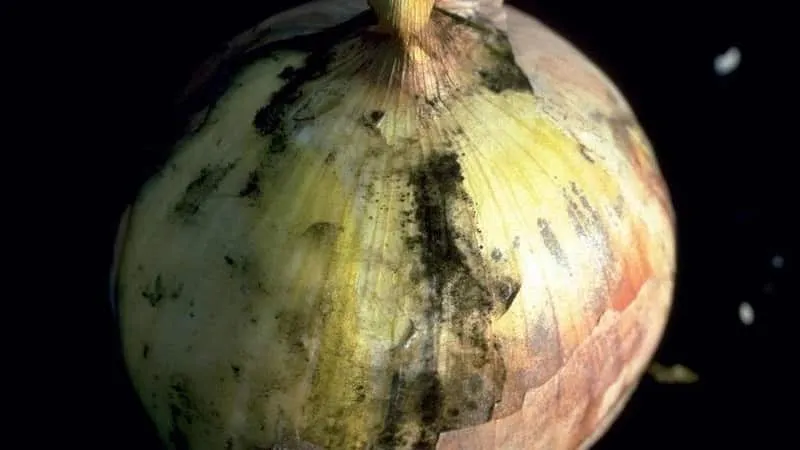
Immature or poorly cured bulbs are most vulnerable. Warm, poorly ventilated storage encourages spread. The pathogen survives in debris and infected bulbs.
Viral Diseases
Beyond fungal issues, onions suffer viral infections like mosaic virus and yellow dwarf virus.
Onion Mosaic Virus
Affects both foliage and bulbs. Look for yellow streaks and light green bands on leaves, which curl and die. Bulb growth stunts or stops.
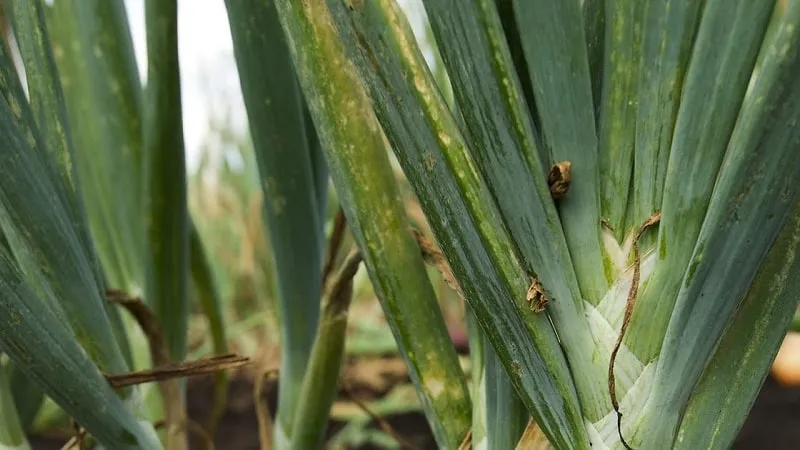
Spread by late planting, overcrowding, and aphids (primary vectors).
Yellow Dwarf Virus
Affects perennial onions and shallots but not leeks. Symptoms include yellow leaf striping and deformation. Leaves twist and collapse, bulbs grow slowly.
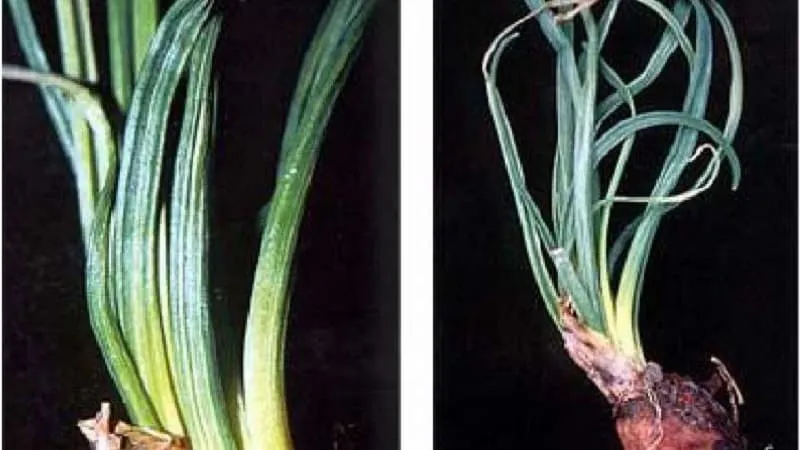
Transmitted via infected sets, dodder (Cuscuta), and certain aphids.
Bacterial Diseases
Bacterial soft rot and black rot threaten onion crops.
Bacterial Soft Rot & Black Rot
Caused by soil-borne or storage-invading bacteria. Outer skins become slimy; inner tissues turn mushy and sticky, emitting foul-smelling liquid when pressed.
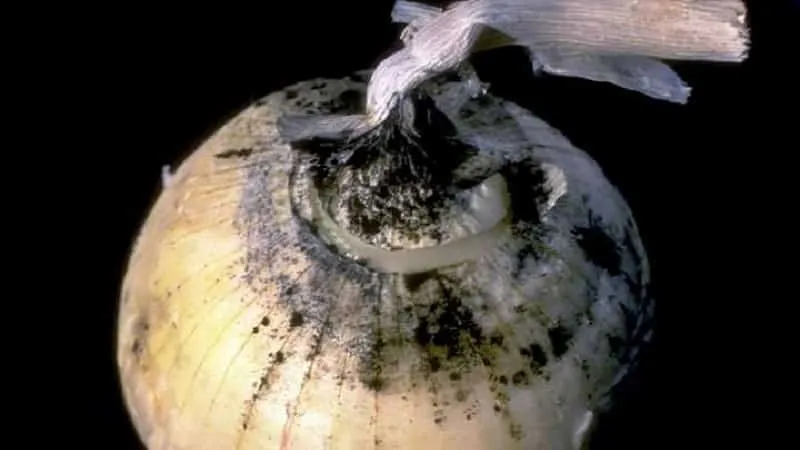
Triggers include waterlogged soil, contaminated ground, improper storage, or pest damage.
Treatment Methods
Act at first disease signs to prevent total crop loss and spread to other plants.
Organic Remedies
Safer than chemicals, these allow immediate consumption of treated crops.
Effective organic sprays include:
- Wood ash solution (50g/10L water). Apply weekly to plants and soil.
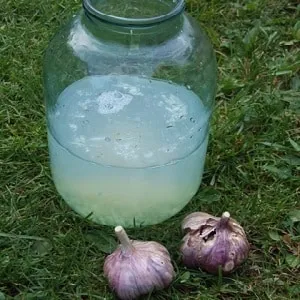 Soured whey. Lactic acid bacteria combat fungi without harming plants. Dilute whey 1:10 with water; spray weekly.
Soured whey. Lactic acid bacteria combat fungi without harming plants. Dilute whey 1:10 with water; spray weekly.- Garlic extract. Crush garlic 1:1 with water, ferment 10 days in darkness. Use 20ml concentrate per 10L water against rot and rust.
- Herbal infusions (horsetail, nettle, wormwood). Soak 1kg fresh plants in 10L water for two weeks. Dilute 1:10 before spraying.
Chemical Treatments
Use chemicals only if organic methods fail.
Caution! Never treat onions grown for greens with chemicals.
Chemical options:
- pre-planting soil treatment with copper sulfate (25-30g/10L water);
- seedling sprays with Bordeaux mixture;
- single application of 0.04% zineb or 0.5% copper oxychloride during leaf growth.
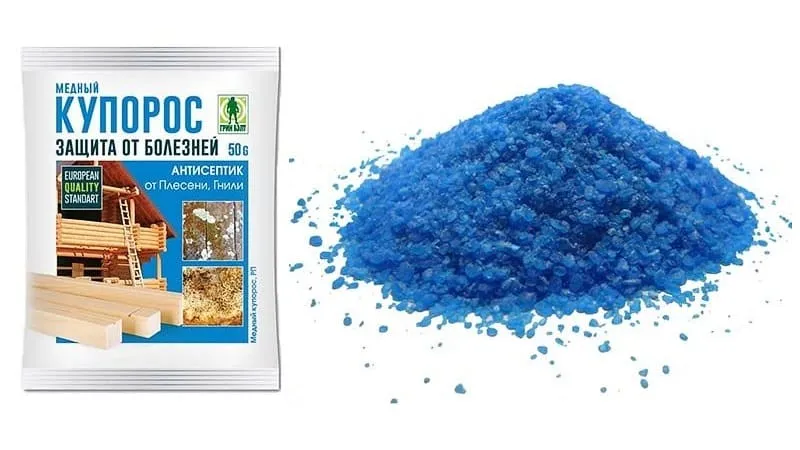
Effective biofungicides include Gliocladium, Fitosporin-M, Alirin B, and Gamair. Apply 3-4 times per season as directed.
Prevention Strategies
Proactive measures minimize disease risks through proper planting, cultivation, harvest, and storage practices.
Pre-Planting Preparations
Essential steps:
- Clear plant debris from soil. Burn infected material.
- Autumn deep-plowing exposes pathogens to winter frosts.
- Pre-plant heat treatment of sets (40°C for 8-24 hours).
- Soaking seeds in Trichoderma-based solutions.
Additional Measures
Further prevention:
- Rotate crops. Replant onions only after 3-4 years. Ideal predecessors: cucumbers, pumpkins, cabbage.
- Grow different Allium species separately.
- Regular plant inspections.
- Thin overcrowded beds; control weeds.
- Morning watering only.
- Store in cool, dark, dry conditions.
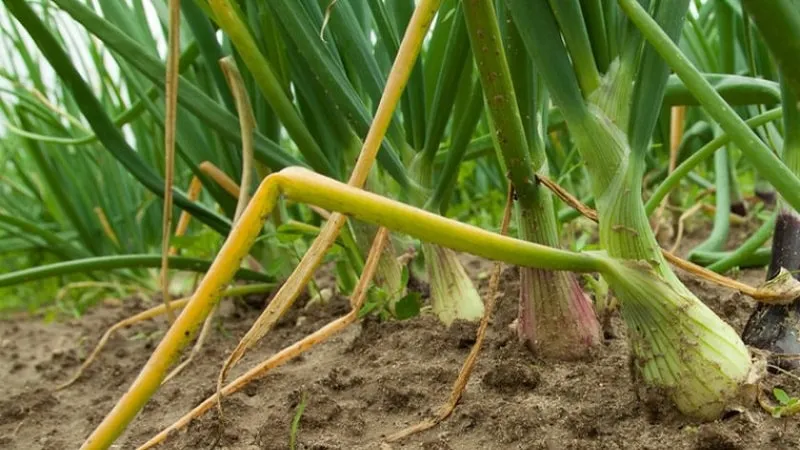
Expert Tips
Seasoned growers recommend:
- Choose locally adapted, rot-resistant varieties.
- Maintain weed-free, well-spaced rows for airflow.
- Plant only disease-free sets.
- Select fertile, loose, well-drained soil. Avoid heavy clay or acidic ground.
- Deter pests with tobacco dust, wood ash, or marigold/dill companion planting.
- Water regularly until early July, then reduce drastically to prevent rot.
- Harvest in dry weather; handle bulbs gently.
- Cure thoroughly in warm, ventilated areas before storage.
- Regularly inspect stored bulbs; discard rotting ones.
Conclusion
Understanding onion diseases is crucial for European growers. Prevent infections through crop rotation, proper watering, pre-planting treatments, and avoiding overcrowding. Quality seed material is equally vital, as many pathogens spread through contaminated sets.







